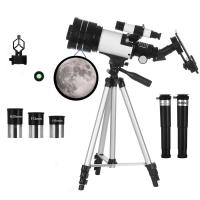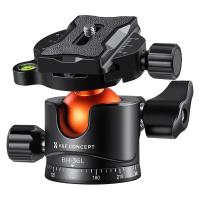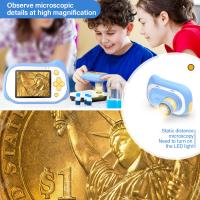What Are The Disadvantages Of A Light Microscope ?
Some disadvantages of a light microscope include limited resolution, which can make it difficult to observe very small details; limited depth of field, which can result in blurry images of three-dimensional objects; and the need for staining or labeling samples to enhance contrast. Additionally, light microscopes are not suitable for observing transparent or translucent specimens, as they may not provide enough contrast. They also have a limited magnification range compared to electron microscopes, which can restrict the level of detail that can be observed. Finally, light microscopes are relatively bulky and require a stable platform for operation, making them less portable compared to other types of microscopes.
1、 Limited resolution for observing small structures.
The light microscope has been a fundamental tool in the field of biology for centuries, allowing scientists to observe and study various biological specimens. However, it is not without its limitations. One of the main disadvantages of a light microscope is its limited resolution for observing small structures.
Resolution refers to the ability of a microscope to distinguish between two closely spaced objects as separate entities. The resolution of a light microscope is limited by the wavelength of visible light, which ranges from 400 to 700 nanometers. This means that structures smaller than the wavelength of light cannot be resolved and appear as a blur or merge together. For example, organelles within cells, such as mitochondria or ribosomes, are often too small to be observed with high resolution using a light microscope.
To overcome this limitation, scientists have developed more advanced microscopy techniques, such as electron microscopy. Electron microscopes use a beam of electrons instead of light, which has a much shorter wavelength, allowing for higher resolution imaging. These techniques have revolutionized our understanding of cellular structures and processes, providing detailed insights into the nanoscale world of biology.
However, it is important to note that light microscopes still have their advantages. They are relatively inexpensive, easy to use, and can provide real-time imaging of living specimens. Additionally, advancements in technology have led to the development of techniques like confocal microscopy and super-resolution microscopy, which have improved the resolution of light microscopes.
In conclusion, while the limited resolution of a light microscope for observing small structures is a disadvantage, it is important to recognize the significant contributions that light microscopy has made to the field of biology. With the continuous advancements in technology, light microscopy continues to be a valuable tool for studying biological specimens.

2、 Inability to visualize live or unstained specimens.
The light microscope has been a fundamental tool in the field of biology for centuries, allowing scientists to observe and study the intricate details of cells and tissues. However, it is not without its limitations. One major disadvantage of a light microscope is its inability to visualize live or unstained specimens.
When using a light microscope, specimens need to be fixed and stained in order to enhance contrast and visibility. This process often involves killing the specimen and introducing chemicals that may alter its natural structure or function. Consequently, the observations made using a light microscope may not accurately represent the true behavior or characteristics of living organisms.
In recent years, there have been advancements in microscopy techniques that aim to overcome this limitation. For example, fluorescence microscopy utilizes fluorescent dyes or proteins to label specific structures within live cells, allowing for real-time visualization. Additionally, confocal microscopy and multiphoton microscopy techniques have been developed to capture high-resolution images of living specimens without the need for staining.
However, these advanced techniques come with their own set of challenges. They often require expensive equipment and specialized training, making them less accessible to researchers with limited resources. Furthermore, the use of fluorescent dyes or proteins may introduce artifacts or interfere with the natural processes of the specimen, potentially affecting the accuracy of the observations.
In conclusion, while the light microscope has been an invaluable tool in biological research, its inability to visualize live or unstained specimens has been a significant disadvantage. However, with the development of advanced microscopy techniques, scientists now have alternative methods to overcome this limitation, although they come with their own set of challenges.

3、 Potential damage to delicate or sensitive samples.
One of the main disadvantages of a light microscope is the potential damage it can cause to delicate or sensitive samples. When using a light microscope, the sample is typically placed on a glass slide and covered with a coverslip. The sample is then illuminated with light, and the image is magnified and observed through the microscope.
However, this process can be harmful to certain samples. The intense light used in a light microscope can generate heat, which can damage or even destroy delicate biological samples. Additionally, the process of preparing the sample for observation, such as staining or fixing, can alter the natural structure or composition of the sample, leading to inaccurate observations or results.
Furthermore, the resolution of a light microscope is limited by the wavelength of visible light. This means that it is not possible to observe objects or structures that are smaller than the wavelength of light, which is around 400-700 nanometers. This limitation prevents the observation of very small details or structures, such as individual molecules or atoms.
In recent years, advancements in microscopy techniques have addressed some of these disadvantages. For example, confocal microscopy uses laser scanning to reduce photodamage and improve resolution. Super-resolution microscopy techniques, such as stimulated emission depletion (STED) microscopy and structured illumination microscopy (SIM), have also been developed to overcome the diffraction limit of light and achieve higher resolution.
Despite these advancements, the potential for damage to delicate samples and the limited resolution of light microscopes remain significant disadvantages. Researchers must carefully consider the nature of their samples and the specific requirements of their experiments when choosing a microscopy technique.

4、 Limited depth of field and field of view.
The light microscope is a widely used tool in scientific research and education due to its ability to magnify and visualize small objects and structures. However, it is not without its limitations. One of the main disadvantages of a light microscope is its limited depth of field and field of view.
Depth of field refers to the range of distances from the lens at which objects appear in focus. In a light microscope, the depth of field is quite shallow, meaning that only a small portion of the specimen can be in focus at any given time. This can make it difficult to observe three-dimensional structures or objects with varying depths. Additionally, the field of view, or the area that can be seen through the microscope, is relatively small. This can be problematic when trying to study large specimens or when trying to locate specific structures within a sample.
Another disadvantage of light microscopes is their limited resolution. Resolution refers to the ability to distinguish between two closely spaced objects as separate entities. Light microscopes are limited by the wavelength of visible light, which restricts their resolution to around 200-300 nanometers. This means that structures smaller than this limit cannot be resolved and may appear blurred or indistinct.
However, it is important to note that advancements in technology have led to the development of more sophisticated light microscopes, such as confocal and fluorescence microscopes, which can overcome some of these limitations. These microscopes use techniques such as laser scanning and fluorescent labeling to enhance resolution and provide clearer images. Additionally, the use of digital imaging and computer software has allowed for the stitching together of multiple images to create a larger field of view.
In conclusion, while light microscopes have limitations such as limited depth of field, field of view, and resolution, advancements in technology have helped to overcome some of these drawbacks. Nonetheless, it is important for researchers and scientists to consider the limitations of light microscopes when choosing the appropriate tool for their specific research needs.







































